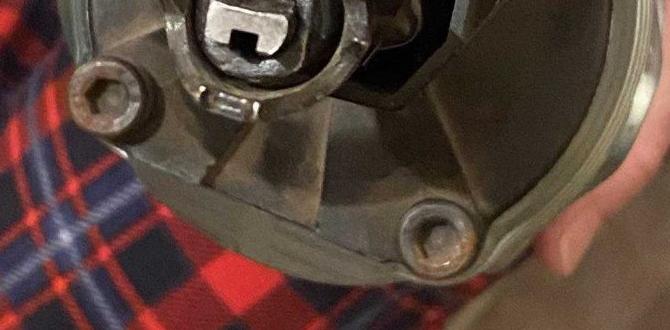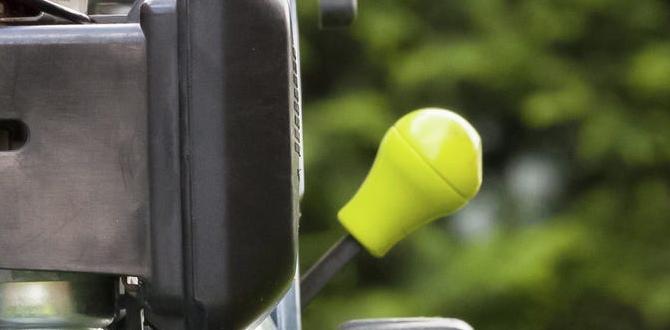Summary: Understanding nail collation angles ensures your nailer fires nails into your project at the right spot. Choosing the correct angle—like 21°, 28°, or 34°—matches your nailer’s magazine for a perfect, jam-free connection every time. This guide breaks down why it matters and how to get it right.
Ever grabbed a box of nails, only to find they don’t quite fit your nailer? It’s a common frustration in any workshop, especially when you’re eager to get a project done. The culprit? Often, it’s the nail collation angle. Don’t worry, it’s not as complicated as it sounds! Understanding these angles is key to ensuring your nail gun works smoothly, safely, and effectively. It’s like making sure two puzzle pieces click perfectly. This guide will walk you through what nail collation angles are, why they’re so important for compatibility, and how to choose the right ones for your projects. Let’s dive in and make sure your nailer and nails are always a perfect match!
Table of Contents
What Exactly is Nail Collation?
Before we talk angles, let’s quickly cover what “collation” means in the world of nails. Collation is simply the process of arranging nails in a strip so they can be fired by a nail gun, one after another. Think of it as how the nails are held together and presented to the nail gun’s firing mechanism. Different nail guns are designed to accept nails collated in specific ways. This collation usually involves holding the nails together with either a plastic strip, a metal band, or adhesive. The angle comes into play with how those nails are connected within that strip.
Why Nail Collation Angles Matter: The Compatibility Connection
Here’s where the magic—and the potential frustration—happens. Nail collation angles are designed to make the nails feed smoothly from the magazine of your nail gun and drive straight into your material. The angle refers to the degree at which the heads of the nails are set relative to the shank (the long metal part). If you use nails with the wrong collation angle, several things can go wrong:
- Jams: This is the most common issue. The nails won’t feed correctly, leading to frustrating jams that stop your work.
- Inconsistent Drives: Nails might not drive straight, leading to bent nails or fasteners that don’t sit flush with the surface.
- Damage to Your Nailer: Forcing incompatible nails can damage the feed mechanism or the driver blade of your nail gun.
- Reduced Efficiency: Constantly dealing with jams and misfires slows down your work significantly.
The angle on the nail strip ensures the nail head is positioned just right within the nail gun’s nosepiece so it transitions smoothly from the magazine to the firing line. It sounds like a small detail, but it makes a huge difference in how your tool performs.
Common Nail Collation Angles Explained
You’ll typically encounter a few standard collation angles in the world of nail guns. Knowing these will help you identify what you need. The most common angles are:
- 21° (Round Head): Often referred to as a “full round head” or “round head” nail. These are very common for framing and structural work. The collation makes them feed well into heavy-duty framing nailers, which are built to drive these larger nails.
- 28° (Off-Set Round Head): These nails have slightly offset heads. They are a very popular choice for framing because they offer a good balance of holding power and ease of driving, and they feed reliably in many framing nailers.
- 34° (Plastic Collated): You’ll often see these referred to as “Paslode” nails (a popular brand) or “plastic collated” nails. The very small plastic strips holding these nails are barely visible after driving, offering a cleaner finish than some metal-collated nails. They are common in various applications, including framing and sheathing.
- 15°-20° (Thin Wire Nails): Used for less structural applications like trim work or finishing where a smaller, less visible fastener is needed.
It’s important to note that while the angles are standardized, the type of collation (plastic, paper, or wire collation) can also influence compatibility, though the angle is the primary factor for feeding.
How to Find the Right Collation Angle for Your Nailer
So, how do you figure out which angle your nailer needs? It’s usually straightforward, but it’s worth checking!
1. Check Your Nailer’s Manual
This is always the best first step. Your nailer’s user manual will explicitly state the recommended nail collation angle and type. Manufacturers design their nailers to work with specific nail specifications for optimal performance and safety. If you’ve lost your manual, a quick search online for your nailer’s model number and “manual” should help you find a digital copy.
2. Look for Markings on the Nailer
Some nail guns have the compatible collation angle printed directly on the tool itself, often near the magazine or on a sticker. This is a handy visual reminder.
3. Examine the Nails You Currently Use (If Any)
If you already have a nailer and it’s working well with a certain type of nail, check the packaging of that nail box. It will clearly state the collation angle and type. You can then buy more of the same.
4. Consult the Manufacturer’s Website
Most tool manufacturers provide detailed specifications for their products online. You can usually find charts or specification sheets that list compatible fasteners for each nail gun model.
5. Consider the Project Type
While your nailer dictates the angle, the type of project often suggests the collation angle and nail type. For instance:
- Framing: Typically uses 21° or 28° round head or clipped head nails for structural integrity.
- Sheathing: Similar to framing, often uses 21° or 28° nails.
- Roofing: Uses specialized roofing nailers with specific collation angles, often for plastic-collated, wide-head nails.
- Siding: May use 15° or 21° nails, depending on the siding material and nailer.
- Trim and Finish Work: Often uses 15° to 20° nails with plastic collation for a cleaner look.
It’s crucial to match the nailer’s capability to the project’s requirements. For a deep dive into different nailer types and their uses, resources like Tooling.com’s guide to choosing nail guns can offer excellent supplementary information.
Understanding Visual Differences in Collated Nails
Once you know the angle, you might wonder about the visual differences between nail strips. This helps in confirming you’re looking at the right type of fastener.
Here’s a table highlighting the common visual distinctions:
| Collation Angle | Typical Head Type | Collation Material | Common Applications | Visual Cues to Look For |
|---|---|---|---|---|
| 21° | Full Round Head | Paper or Plastic | Framing, sheathing, general construction | Heads are fully rounded, often larger. The paper or plastic strip holding the nails is usually visible. |
| 28° | Slightly Off-Set Round Head | Paper | Framing, construction | Heads are rounded but not perfectly flat against the strip. The paper strip is typically robust and clearly visible. |
| 34° | Round Head (often slightly clipped) | Plastic | General construction, framing, some siding | The nails are held together by very thin plastic strips, which often break away cleanly during driving. The heads are typically well-aligned. |
| 15° – 20° | Clipped Head or Round Head | Plastic or Wire | Trim, finish carpentry, light framing | Nails are much thinner. Heads may be “clipped” to drive flush without protruding much, or smaller round heads. The plastic or wire collation is much finer. |
Remember, while the angle is crucial for compatibility, the head type and collation material also play roles in the nail’s performance and appearance on your project.
Plastic vs. Paper vs. Wire Collation: Does it Matter for Angle Compatibility?
While this article focuses on angles, it’s worth a quick mention of collation materials because they sometimes go hand-in-hand with specific angles and nailer types.
- Plastic Collated Nails: Very common, especially for framing and construction. The plastic strips are often slender and designed to break away cleanly when the nail is driven, leaving minimal debris. Many 34° nails are plastic collated.
- Paper Collated Nails: Also widely used for framing and construction. The paper strips are generally stronger than plastic ones and provide good support. Many 21° and 28° nails are paper collated or have paper tape holding them together.
- Wire Collated Nails: Less common for power nailers that require angled collation. These are more often found in lighter-duty coil nailers or for specialized applications.
For your nailer to function correctly, it’s designed to accept a specific angle of nails, regardless of whether they are held by plastic or paper. However, sometimes a nailer is designed for a specific collation type alongside the angle. Always default to your nailer’s manual!
Step-by-Step: Ensuring Nail Compatibility
Let’s break down the process of making sure you’ve got the right nails for your nailer.
Step 1: Identify Your Nailer’s Angle Requirement
- Locate your nail gun.
- Find the user manual, check for stickers on the tool, or search online for your model’s specifications.
- Note down the required collation angle (e.g., 21°, 28°, 34°).
Step 2: Identify Your Nailer’s Collation Type (If Specified)
- Your manual or tool markings might also specify the type of collation (e.g., plastic, paper).
- Note this information down. While angle is primary, some nailers are designed for a specific collation material to ensure smooth feeding.
Step 3: Read the Nail Packaging Carefully
- When purchasing nails, always check the box. It will prominently display the collation angle (e.g., “21° Framing Nails”) and often the collation type.
- Ensure the angle and, if applicable, the collation type match what your nailer requires.
Step 4: Visually Inspect the Nails
- Before loading, take a look at the strip of nails.
- Do the nail heads appear to be set at an angle relative to the strip?
- Does the collation material look like plastic or paper?
- Compare this to nail types you know are compatible (if you have any on hand).
Step 5: Perform a Test Load and Fire (Safely!)
- If you are still unsure after checking packaging and the tool, and with the nailer unloaded and unplugged/battery removed for safety, carefully insert a strip of nails into the magazine.
- Gently slide the follower arm to push the nails forward. Do they feed without binding or excessive force?
- Then, with the nailer still unloaded and aimed at a safe piece of scrap wood, and following all safety precautions (see below!), perform a single test fire. Listen for smooth operation.
- Safety First: Always ensure your nailer is unplugged or the battery is removed when performing visual checks or test loads. When test firing, wear safety glasses, point the nailer in a safe direction, and ensure no people or pets are nearby.
Common Mistakes to Avoid
We all make mistakes, especially when starting out. Here are a few common pitfalls regarding nail collation angles that you can steer clear of:
- Assuming all “framing nails” are the same: Framing nailers come in different angles, so the nails must match.
- Overlooking the manual: It’s the definitive source for compatibility. Don’t guess when the answer is in black and white.
- Buying the cheapest nails without checking specs: While budget is important, incompatible nails will cost you more in frustration and potential tool damage.
- Mixing brands without verification: While many brands are compatible, always double-check specifications rather than assuming.
- Not considering depth of drive: While angle is about feeding, make sure the nail size and type are also appropriate for your material to achieve the correct depth of drive. Resources like Fine Homebuilding have excellent tips on safe and effective nailing techniques.
When to Consider Different Nailer Types
Sometimes, the frustration with nail collation isn’t about buying the wrong nails, but about using the wrong type of nailer for the job. If you find yourself consistently needing different collation angles for different tasks, it might be time to invest in more than one type of nail gun. For example:
Framing vs. Finish Nailers
Framing nailers (usually 21° or 28°) are robust and designed for structural work. Finish nailers (often 15° or 16°) are lighter and designed for trim work, where a less visible fastener is desired. You wouldn’t use a finishing nailer for framing, and vice-versa.
Coil vs. Stick Nailers
Stick nailers use nails collated on a strip (like the angles we’ve discussed). Coil nailers use nails held together in a round coil, typically with wire or plastic. They have entirely different collation mechanisms and angles.
Understanding your tool collection and the specific collation requirements for each will save you a lot of trouble. For instance, many professional builders have a dedicated framing nailer and a dedicated finish nailer.
Safety First!
Nail guns are powerful tools and require respect. Always prioritize safety. This includes:
- Wearing safety glasses: Always wear ANSI-approved safety glasses when operating or near a nail gun.
- Keeping fingers away from the trigger and nose: Never point the nail gun at yourself or others. Store it safely when not in use.
- Ensuring proper ventilation: If using pneumatic nailers, ensure adequate airflow. For electric or cordless models, follow manufacturer guidelines.
- Disconnecting power: Always disconnect the air hose, battery, or power cord before loading nails, performing maintenance, or leaving the tool unattended.
- Understanding safety features: Most nailers have a contact fire safety mechanism, requiring the nose to be pressed against a surface before the trigger will operate. Ensure this is functioning correctly. For more on tool safety, check out resources from the Occupational Safety and Health Administration (OSHA), which outlines safety requirements for tools like nail guns.
Frequently Asked Questions (FAQ)
Q1: Can I force a nail with the wrong angle into my nailer?
A: It’s strongly advised not to. Forcing incompatible nails can lead to immediate jams, damage the nailer’s feeding mechanism, break the driver blade, or cause the nail to fire incorrectly, potentially leading to injury or a ruined project.
Q2: My nailer is listed as compatible with 21° nails. If I use 28° nails, will they fit in the magazine?
A: Physically, a strip of 28° nails might fit into a 21° magazine, but they are unlikely to feed correctly. The angle mismatch will cause the nails to bind in the feed path. Always use the exact angle specified for your nailer for reliable performance.
Q3: What does “clipped head” mean in relation to collation?
A: A clipped head nail has a portion of the head removed, usually to allow the nails to be set closer together on the strip. This is common in thinner nails used for finishing or trim work. The collation angle still applies to how these clipped heads are presented.
Q4: I bought a box of nails, and the angle is correct, but they still jam. What else could be wrong?
A: While angle compatibility is key, other factors can cause jams. Ensure the nails are the correct diameter and length for your tool, the magazine is clean, the driver blade isn’t damaged, and you’re using the correct pressure if it’s pneumatic. Sometimes, individual nail defects can also




